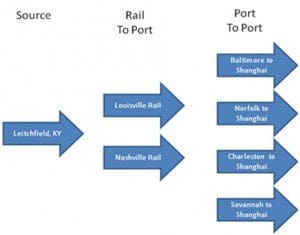In recent months I’ve talked to two natural resource companies that have implemented a transportation management system (TMS) and have achieved very different outcomes. Both companies had similar goals: reduce freight spend and improve service. But only one company achieved success on both fronts; the other has had limited success in improving service.
The company that achieved success was Baillie Lumber, a leading manufacturer and exporter of hardwood lumber to furniture, cabinet, and hardwood floor manufacturers around the world.
The company that failed? I won’t name them.
At the OTM Special Interest Group last August, I attended a presentation by John Vitale, IT Director at Baillie, about the company’s implementation of Oracle Transportation Management (OTM). John was kind enough to have a follow-up phone conversation with me to fill in some details.
Baillie moves lumber on flatbed trucks. There are not many large carriers that compete for flatbed moves. Baillie actually gets its best rates on the spot market. In short, the company’s ability to drive savings in its domestic business, which relies on trucking, was limited.
Baillie’s largest TMS ROI bucket is on the export side and is based on optimized routing. Routing is something that many people associate with multi-stop truck movements, but it also applies to global moves. Here is a simplified example of the shipping options that exist between one of Baillie’s plants in Leitchfield, Kentucky and a port in Shanghai.
In reality, there are many optimization runs that generate more than six options, which OTM automatically lists with the lowest-cost route on top and the highest-cost option listed last. Based on the number of shipments Baillie does, and the complexities associated with global moves, the company needed new hardware so that it could scale to solve the problem sets.
Historically, when I have talked to companies with failed supply chain implementations, they typically do not blame the software company. Rather, they admit that the fault was their own, usually because they couldn’t change their internal culture, especially if a project requires the sales force to change the way it wants to do business.
This was the case with the failed TMS implementation. This company had customers complaining about late deliveries. The TMS was implemented, in part, so that the company could give potential customers more accurate estimated time of arrivals as part of the quote. But in many cases, the sales force ignored the estimated time of arrivals from the TMS and promised quicker than feasible delivery dates to win business. The transportation analyst responded by creating and publishing an average days late report. The average is currently less than 10 days late, but it was substantially greater in the past. There is evidence that this is driving new business and increased wallet share on lanes where the company can consistently hit the promised delivery date. But the sales quotas, combined with a lack of executive oversight and support, has made progress much slower than it should have been.
Baillie has a very different culture. At Baillie, the President and top management actually continue to sell. They have their own accounts and have to face their customers on an ongoing basis. Consequently, when the TMS project started, the top executives clearly understood the problems and provided the executive-level support necessary.
Baillie sets targets for its sales force, but there are targets for both revenue and margin. The IT department generates daily reports that show how all the salespeople are performing to both their revenue and margin targets, up to date as of midnight the previous day. Salespeople can’t maximize revenues by “low balling” transportation costs without taking a hit on margin.
The sales force should not always quote the low-cost option. Usually the quoted price, which includes transportation costs, is given to the customer before carriers can confirm that they can take the load. The shipment may end up going out on a higher-cost route than initially estimated. The transportation manager can add comments to the options to help guide the sales force. When a salesperson pulls up the different route options on their Blackberry, they may see a note that the low cost ocean carrier on a particular lane is having a hard time supplying containers. Or perhaps a particular carrier’s charges will go up $400 on this lane next month. Further, sales people need to understand what their customers want. A customer, for example, may ask them not to use a particular carrier because they have performed poorly in the past.
Baillie’s goal for the future is to have the transportation options displayed on the salesperson’s Blackberry show up with an asterisk next to the suggested route. How they will balance predicted service levels and cost has yet to be fully worked out. An IT Director’s work is never done.
(Note: Oracle is an ARC client)

















